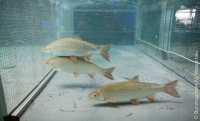Etho-hydraulic tests at the BAW
From BAWiki

So-called etho-hydraulic tests serve to gain an understanding of how water flow influences fish behaviour and use this to set out corresponding requirements for an approach to hydraulic engineering that is sustainable from the point of view of fish ecology. The discipline of etho-hydraulics combines ethology (comparative behaviour research) with hydraulics. These tests are designed and conducted by an interdisciplinary team of researchers from the Federal Waterways Engineering and Research Institute (BAW) and the German Federal Institute of Hydrology (BfG) specialising in hydraulics and behavioural and fish ecology respectively.

The animal behaviours observed in the laboratory under reproducible conditions have to be transferrable to real-life situations. To this end, the geometric and hydraulic boundary conditions of the test structure must be similar to those occurring in nature. This requires as large a scale model as possible (ideally 1:1); however, the drawback of this is that the modelling process is restricted since only a small number of external factors can be taken into account.
Fish behaviour is documented during the test by logging data manually, measuring times and taking video recordings and measuring the hydraulic conditions in detail. The findings from these tests help to identify advantageous or disadvantageous effects of certain flow patterns or structural designs on fish behaviour, with various statistical methods used to evaluate the test data.
Etho-hydraulic tests cannot be carried out without permission in accordance with the German Animal Protection Act (Tierschutzgesetz). They require special qualifications in fish biology as well as adequate infrastructure. An etho-hydraulic test station was set up at the BAW in spring 2016 in partnership with the BfG. It was placed in a test flume measuring 2.5 metres wide by some 60 metres long. This required installing new pumps and storage tanks and creating a separate water circuit.
The fish tests at the BAW are focusing on the navigability of fish ladders. These tests form part of a joint BfG/BAW R&D project to establish a measurement framework for dimensioning effective fish ladders on Germany's federal waterways.
Back to: Main Page
